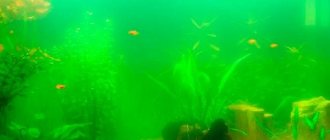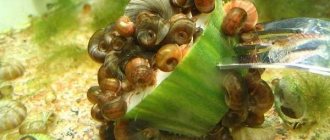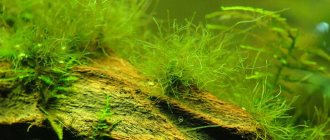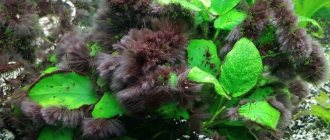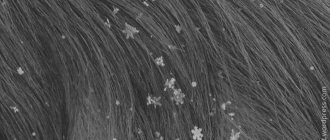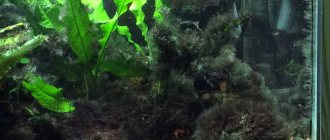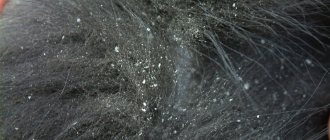Everyone who keeps an aquarium has at least once encountered white worms appearing in it. Most often these are nematodes or, simply put, roundworms that live in any environment, which can be soil and water. An experienced aquarist will immediately say that there is nothing wrong with this, while a beginner will be clearly frightened by the appearance of helminths in an aquarium with pet fish.
For a person, any worms are something unpleasant and creepy, so after discovering them, many are even afraid to put their hands in the water, not to mention fully caring for their fish.
What to do in such a situation? To get started, we recommend reading this article. This article describes in detail methods of controlling parasites. We also recommend that you consult a specialist. Read the article >>>
It is assumed that parasites appear only in advanced cases, when a person does not care about the container and contents. But this is not true, because nematodes in an aquarium can develop at a rapid pace, regardless of what conditions the aquarist has created.
Today, this roundworm is the most common type of helminth and affects humans, animals and plants. Some subspecies of nematodes reach enormous sizes, up to almost 8 meters in length. There are about 20 thousand varieties of this worm, all of them live not only in humans or animals and can be found in fish, crustaceans, wild animals, as well as in plants, such as mushrooms or cereals.
As medical studies have shown, the largest roundworms were seen in whales and reached several meters in length, but most often, nematodes are small parasites a few millimeters long.
If you notice white worms on the walls of your aquarium, do not be alarmed; of course, it is an unpleasant feeling that, in addition to fish, you have some kind of parasites in your aquarium, but you can get rid of them.
The most common helminths that appear in the aquarium
Let's first understand what a parasite is. There are three types of worms that most often settle in an aquarium:
Nematodes
Nematodes are also called microworms, they are indeed the most common throughout the world and are multicellular organisms. Most often they swim freely throughout the aquarium, both independently and thanks to a stream of water from the aquarium filter.
Many people are interested in the question of whether nematodes are dangerous in an aquarium and whether it is possible to destroy the helminth without harming the fish? In fact, you can get rid of them in a short time, while the helminths themselves do not affect the inhabitants of the aquarium in any way, but clearly cause a lot of problems for its owner. Agree, it’s unpleasant to enjoy fish and suddenly notice small white worms swimming past them.
The appearance of white worms is possible immediately after purchasing algae; often it is in the vegetation that a large number of parasites are hidden, which subsequently clog the aquarium.
Hydra
Hydra is a type of white worm that lives in water, and its main feature is the ability to grow even after being split in half. New individuals instantly “come to life” and lead a full-fledged lifestyle. They are also completely safe for fish and other aquarium inhabitants.
Theoretically, an adult hydra can eat eggs and fry, but as practice shows, in reality this happens extremely rarely. As a rule, hydras have enough regular aquarium food, which is quite suitable for them in its nutritional properties.
Planarians
Planarians are also a type of parasite that lives in water. These are very dangerous worms, very different from nematodes. The problem is that they cannot be detected, since they often hide in algae or even in the ground, since adults cannot tolerate daylight hours.
In appearance, planaria has some visual differences from the above-mentioned helminths. In the upper part, the worm's head is much thicker compared to the rest of the body.
If you divide the planaria into several parts, they will all lead a full life, growing back. These parasites eat everything they come across, and the more food they eat, the more actively they multiply. Because of planaria, fish suffer, since the helminth eats fry and eggs, sometimes they can even attack crustaceans.
Prevention
A number of simple measures will eliminate the need to fight worms.
Every 7 days it is necessary to clean the aquarium and partially change the water. Before using stones and decorations, they are thoroughly disinfected. The stones are cleaned of moss and dirt and calcined in the oven.
The decor is also washed with warm water and, if the material allows, left in a pink solution of potassium permanganate for a day, after which it is rinsed and allowed to dry. Soil and sand can also be kept in the oven.
If you cannot do without live food, then it is better to buy it in stores rather than get it yourself. You need to be especially careful when feeding fish with tubifex, insect larvae, and copepods.
Getting rid of worms
White worms cause a lot of trouble for aquarium owners. They will appear from an excess of food, poor quality food, with new aquatic plants and decorations. If you don't know what kind of parasite is infested, try raising the water temperature a few degrees and adding table salt. This will not harm the aquarium inhabitants, but will kill ordinary nematodes. If it does not help, then the white worm is a parasite. Methods for getting rid of parasites in an aquarium depend on the type of helminths:
- Planaria should be removed from the aquarium immediately. But this is difficult to do. Aquarium parasites are afraid of light, and therefore are found in the ground and come out only in the dark. Until the owner discovers the parasites, a lot of them can breed. At the same time, they are not afraid of being cut into pieces; they feed on everything that is in the tank. One way to get rid of planaria is to make traps. A piece of meat is wrapped in gauze and placed in the tank at night. The soil should first be siphoned to lift parasites from the bottom. In the morning, the trap is pulled out together with the worms that have pecked at the treat. The method is not very effective; it will not be possible to completely get rid of helminths.
- Worms cannot tolerate fenbendazole. Therefore, drugs containing it are the only salvation if a white worm appears.
- Since turbellaria can appear on the walls of the aquarium, in order to get rid of the white worm, it is necessary to clean the glass and maintain a water temperature of 35 degrees for several hours. Fish and other inhabitants are first removed from the container. After the procedure, the water is cleaned. You can release fish after reaching the optimal temperature for the inhabitants.
- Worms in the aquarium nematodes appear due to an excess of food. This may be the case if the water purification filter is not working well, or you spill a lot of food. You can get rid of the parasite using labyrinthine fish species, such as gourami. If the organic balance of the reservoir is disturbed, the parasites will start again.
- If a hydra appears, the aquarium gets rid of it only by restarting it with a complete replacement of water and decorations. No matter how much you try to reduce the number of parasites by regularly cleaning the tank and removing worms, they will appear again. Get gourami, pond snails or mollies, they feed on hydras.
If the aquarium is not inhabited by plants, remove fish from it and heat the water to 40 degrees. The temperature should be maintained for 2 hours.
Nematodes as food: breeding and growing methods
Nematodes are a favorite treat for many aquarium fish. In order to breed and raise worms for food, they use various containers with a shape similar to wide, shallow plates. The procedure does not cause any difficulties and is carried out as follows:
- The bottom of the container is lined with food (layer thickness - 15–20 mm).
- Place a piece of the old culture on the layer of food (if you have already grown this type of biofeed before) or a starter culture purchased at a pet store.
- Glass with a piece of foam rubber glued inside is placed on the container, which must be periodically moistened (if the container is hermetically sealed, foam rubber is not needed).
The following foods are used as a nutrient medium for breeding roundworms:
- porridge based on oats, barley or oatmeal flour, with a small amount of milk;
- oatmeal flour with grated carrots, scalded with boiling water, with the addition of multivitamins;
- thick oatmeal;
- bread soaked in milk;
- white bread (without crust), poured boiling water, squeezed out and cooled;
- finely grated carrots, brewed with boiling water (the root vegetable processed in this way can be added to other types of food);
- thick curdled milk.
Important! All feed for breeding nematodes should have the consistency of thick porridge. In a liquid environment, the larvae may die. The cultivator is installed in a dark place with an air temperature of +22…+28 °C. After 48–96 hours, the roundworms will begin to actively reproduce.
To collect biofeed, a smooth object (domino, piece of plastic, etc.) is placed on the nutrient medium, which will soon be covered with young worms. Harvesting is carried out using a brush, which after the procedure should be rinsed in a container with clean water. When the nematodes settle to the bottom, the cloudy water is drained. Do this several times until the water becomes clear.
It may happen that the worms themselves try to crawl out of the cultivator along the walls, in which case it is enough to collect them with a brush and rinse the brush in the aquarium.
In the aquatic environment, nematodes live for approximately 48 hours. Since the worms settle on the ground, the water should be stirred up periodically; some fry will not eat food lying on the bottom.
Not all fish eat nematodes, but vinegar eels mixed with carrots are happily consumed by any fish. The grated carrots are placed in a cultivator, and the crop is laid on top of it. In such an environment, fairly rapid reproduction occurs and a carrot-colored nematode appears, which fish readily eat.
Video: Breeding nematodes at home If, when breeding roundworms, you notice an unpleasant odor or the nutrient medium begins to change color, change the container and start the culture again. If the nutrient medium becomes too liquid, add oatmeal to it until the desired consistency is obtained.
Did you know? The nematode Halicephalobus mephisto lives in the earth's crust at such a depth that no other multicellular creature living on our planet descends.
Fish infected with nematodes
Parasitic worms, of which there are more than 6,000 species, infect aquarium fish. This is especially true for exotic species from the tropics. If this happens, one individual will destroy the entire school of fish within a few months. They become infected both from each other and through waste products.
If the infection occurred recently, you can understand the malaise by the lethargy of the fish and the abundant consumption of food. As the parasites develop, the belly swells and the spine may become bent. As a result, the fish will die.
Whatever the species of nematodes, their presence in the aquarium brings discomfort. If you cannot cope with helminths, contact a specialized store. Consultants will help you choose the right remedy to combat helminths.
FAQ
Are free-living nematodes dangerous for humans?
Worms living in an aquarium do not harm humans. This type of nematode is adapted to life only within the aquarium ecosystem.
Is it possible to become infected with parasitic nematodes?
You can become infected by eating contaminated raw fish or by ignoring hygiene rules.
Can purchased fish be immediately placed in an aquarium if it does not show signs of worm infection?
No, this cannot be done, even if the individual looks healthy. First, she is placed in quarantine, and only after making sure that she will not harm other residents is she moved to a permanent place.
Main types
There are free-living roundworms and parasitic nematodes. Let's consider their features.
Regular
The favorite habitats of free-living roundworms are freshwater bodies of water, seas and soil. In such an environment, their density can reach 1 million/cubic meters. m, nematodes take an active part in the functioning of ecosystems.
Free-living roundworms do not pose a danger to living organisms; their lifespan is no more than a few days. They are extremely dependent on the availability of water; fluctuations in moisture concentration are fatal for them. Salty soils are also not suitable for them.
Parasitic
But parasites are extremely resilient. They tolerate any influence of an aggressive environment and unfavorable external factors. A special feature of worms is that during such periods of the life cycle their reproductive function is noticeably enhanced.
In an aquarium, parasitic worms can quickly infect and soon destroy the entire population of fish and vegetation. Nematodes develop in several stages and can have two or more hosts: the larva parasitizes one living creature, the adult worm moves to another. As the parasite develops, it travels from one organ to another, leaving larvae there, thus infecting the entire body. Most of the representatives of the genus parasitize (or exist as commensals) on almost all types of living beings - from protozoa to humans. Nematodes that parasitize plants cause nematode diseases, and living creatures develop nematodes.
Nematode plant diseases affect the root system; invasive diseases pose a danger to living organisms. The most famous parasites of this type found in humans are pinworms, roundworms, and trichinella.
It is possible to defeat parasites!
Antiparasitic Complex® - Reliable and safe removal of parasites in 21 days!
- The composition includes only natural ingredients;
- Does not cause side effects;
- Absolutely safe;
- Protects the liver, heart, lungs, stomach, skin from parasites;
- Removes waste products of parasites from the body.
- Effectively destroys most types of helminths in 21 days.
There is now a preferential program for free packaging. Read expert opinion.
Read further:
Algae parasites in the aquarium: examples, description and control methods
Demodex on the face: reasons for its appearance, how to get rid of it, the best ointments
Aquarium fish parasites: worms, algae, name and description
Types of roundworms (nematodes): description and general characteristics of parasites
Mesophiles in animals and plants, reproduction temperature
What do worm larvae look like: round and tapeworms, flukes
